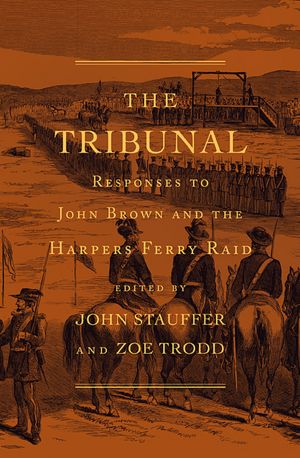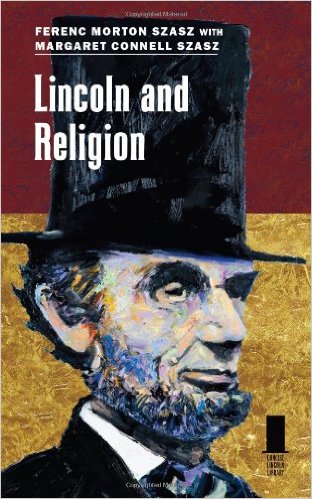The Tribunal: Responses to John Brown and the Harpers Ferry Raid edited by John Stauffer and Zoe Trodd. Harvard University Press, 2012. Cloth, ISBN: 0674048857. $39.95.
 The Tribunal: Responses to John Brown and the Harpers Ferry Raid is a welcome addition to a small collection of Brown readers, including another by editors John Stauffer and Zoe Trodd, Meteor of War: The John Brown Story. This volume’s title comes from Brown’s declared intent to “leave it to an impartial tribunal” to determine if the world was well-served by his life. Along with traditional sources such as Brown’s 1857 autobiographical letter, Brown’s prison letters, and the famous speech in which Henry David Thoreau declared that Brown had made the gallows as glorious as the cross, Trodd and Stauffer include a host of documents showcasing sectional (and international) responses to the Harpers Ferry raid as well as how Brown was remembered in the post-Harpers Ferry world.
The Tribunal: Responses to John Brown and the Harpers Ferry Raid is a welcome addition to a small collection of Brown readers, including another by editors John Stauffer and Zoe Trodd, Meteor of War: The John Brown Story. This volume’s title comes from Brown’s declared intent to “leave it to an impartial tribunal” to determine if the world was well-served by his life. Along with traditional sources such as Brown’s 1857 autobiographical letter, Brown’s prison letters, and the famous speech in which Henry David Thoreau declared that Brown had made the gallows as glorious as the cross, Trodd and Stauffer include a host of documents showcasing sectional (and international) responses to the Harpers Ferry raid as well as how Brown was remembered in the post-Harpers Ferry world.
A lengthy introduction offers the reader background information alongside sweeping interpretation of Brown, the raid, and its link to the Civil War. The biographical treatment is relatively standard, though unsurprisingly it (as Stauffer did in his award-winning The Black Hearts of Men) emphasizes Brown’s close relationship with African Americans more than other biographers. This, as well as his own experiences of poverty and hardship, drove Brown to violent antislavery action, first in Kansas and then at Harpers Ferry. According to Stauffer and Trodd, Brown’s raid drove a wedge into antislavery politics, leading to Lincoln’s nomination by fearful Republicans, the North-South split of the Democrats, and Lincoln’s election. Brown’s raid ultimately allowed secessionist fire-eaters such as Edmund Ruffin to propel the South toward secession. The documents that follow are divided into five well-framed sections: “In his Own Words”; “Northern Responses”; “Southern Responses”; “International Responses”; and “Civil War and Postwar Responses.” Each section has a short introduction, as does each document contained within it.
“In His Own Words,” is thoughtfully designed to allow Brown to speak for himself at the outset, before other sections highlight diverging responses to and interpretations of the man who Herman Melville in 1866 called “weird John Brown, the meteor of the war” (585). Section two highlights the transformation of northern response in the initial months after Brown’s raid. While a Boston Courier piece from October 20, 1859, referred to the “outlaw ‘Old Brown,’” (99) and an Illinois paper reported the raid as “the inevitable tendency of black republican teaching” (103), many northerners were soon swayed by Brown’s prison demeanor and letters into a broader antislavery sympathy and admiration for his nobility (if not his means). In his eulogy for John Brown, Wendell Phillips proclaimed that Brown had “abolished slavery in Virginia” (214). The following compilation of southern responses in the third section shows how Phillips ultimately proved prophetic. To their credit, Stauffer and Trodd include not just proslavery and secessionist interpretations in the lead up to the Civil War. Instead, they include a host of southern voices, African American and white, unionist and secessionist, famous and obscure. All agreed on one thing: Brown’s raid was a defining moment. Section four, the collection of international responses, allows Trodd and Stauffer to show how Brown’s raid resonated globally, in both 1859 and beyond.
The question of post-1859 reactions to Brown carries into section five, which chronicles American responses to Brown from the Civil War to 1889. Documents include an excerpt from Charlotte Forten’s diary that divulged her joy at teaching her Sea Island pupils “John Brown’s Body” to the Confederate musical reply “John Brown’s Entrance into Hell” (540, 550). It is the sources from 1879 and the 1880s that are the most interesting of the section, however, particularly the Colored Citizen’s early 1879 editorial titled “Wanted, a Few Black John Browns” (599). The collection concludes soon after in 1889, despite the introduction’s gesture to a wealth of interesting anti-lynching and more modern appropriations of and commentary upon Brown’s memory. Though an entire volume (or series) could be compiled of documents relating to John Brown’s memory, one wishes that Trodd and Stauffer had included a few more documents in this section to hint at post-1889 use of John Brown’s image. Unlike most other Brown readers from Franklin Sanborn’s Life and Letters (1885) onward, The Tribunal eschews personal letters written to and from John Brown. In part this is because so many have appeared elsewhere, in their own work and beyond. The inclusion of a few key family letters or interjections into public memory would have made for an interesting addition to section five, though some of the best material lies beyond the 1889 scope, when Brown’s surviving children Annie, Sarah, Jason, and Salmon, as well as John Jr. and Ruth’s surviving spouses, Wealthy Brown and Henry Thompson, gave interviews to Oswald Garrison Villard’s researcher, Katherine Mayo—the transcripts of which are contained in the Villard manuscript collection at Columbia. But all of these wishes are more proof of the compelling nature of The Tribunal than real critique.
This book would work well in a host of undergraduate and even graduate history courses, and it will also interest history buffs and scholars alike who have found recent biographies of Brown by David Reynolds, Evan Carton, Lou DeCaro Jr., Robert McGlone, and, most recently, Tony Horwitz engaging. There are many gems that will be useful particularly to the classroom teacher aiming to show nuanced and widespread reaction to Brown’s raid. Take for example Susan Bradford Eppes, a white thirteen-year-old girl living on a southern plantation. On the day of Brown’s capture, she declared her family’s impatience to get news from Virginia, news that had her declaring her world “topsyturvy” (333).
In their introduction Stauffer and Trodd quote Truman Nelson, who in 1957 noted aptly, “John Brown is the sword in the historian’s shoe. They cannot ignore him, but they try to choke him off in deforming parentheses” (xxi). Though their work isolates Brown, it is not in parentheses. Instead, they aim to show his centrality to Americans living through the Civil War era, and the documents which they compiled do this quite ably.
Bonnie Laughlin-Schultz is an Assistant Profess of History at Eastern Illinois University.
